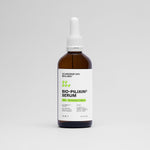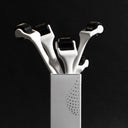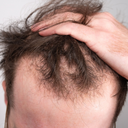As women age, many notice their hair growing slower, thinning, or even shedding. But when does this typically happen, and why?
In this article, we'll explore the age when hair growth tends to slow down, the reasons behind it, and how you can keep your hair healthy for years to come. Let's dive in!
Table of content
At what age hair growth stops in female?

Hair growth doesn't stop completely at a specific age for all women. However, many women begin to notice their hair thinning or growing more slowly in their 40s or 50s. This is often due to hormonal changes and the natural aging process, but genetics and overall health play a role too.
For some women, this process may start earlier or later depending on factors like stress levels, nutrition, and how well they care for their hair.
Understanding when and why this happens can help you make informed decisions about your hair health.
As your leading source for hair health information over the past 4 years, we never compromise on accuracy. When it comes to your health, you deserve information you can truly rely on - and earning your trust is our top priority.
Here's how Scandinavian Biolabs ensures every piece of content meets the highest standards of accuracy and integrity:
- Credentialed Experts: Our reviewers are actively practicing doctors and medical researchers
- Stringent Reviews: Content undergoes rigorous editing by subject specialists and review by a practicing doctor.
- Evidence-Based: We rely on well-established research from trusted scientific sources like peer-reviewed journals and health authorities.
- Full Transparency: Our editorial standards, writer credentials, reviewer credentials, correction process, and funding are all publicly documented.
- Independent Voice: While we do promote products, we operate in a vacuum to business operations. Our main goal is just an unwavering commitment to providing medically-sound guidance.
You can count on Scandinavian Biolabs to consistently deliver the trustworthy health information you deserve. Read our Editorial Standards.
What is the normal hair growth cycle in females?
Hair growth in women follows a natural cycle made up of three phases. This cycle continues throughout life but can slow as you age. Here’s a brief look at the cycle:
- Anagen (Growth phase): Lasts 2 to 6 years, where the hair actively grows.
- Catagen (Transitional phase): Lasts 2 to 3 weeks, where growth stops, and the follicle shrinks.
- Telogen (Resting phase): Lasts about 3 months, where the hair sheds, and new hair starts growing.
What factors can affect hair growth in women?
Several factors can either help or hinder hair growth in women. These include:
- Age: Hair growth slows as you age, mainly due to a drop in estrogen levels.
- Hormonal changes: Puberty, pregnancy, and menopause can affect how your hair grows.
- Genetics: Hair thickness and growth patterns often run in the family.
- Nutritional deficiencies: Lack of vitamins like biotin and zinc can weaken hair.
- Stress: Chronic stress can cause hair loss due to hormonal imbalances.
- Medical conditions: Conditions like thyroid disorders and autoimmune diseases can disrupt the hair growth cycle.
- Hair care practices: Excessive heat, tight hairstyles, and harsh chemicals can damage your hair.
Does menopause affect hair growth in women?

Yes, menopause often leads to hair thinning and loss. The drop in estrogen levels during menopause disrupts the hair growth cycle, causing more hair to shed and less to grow. While this can be distressing, there are treatments available to help manage hair loss during this phase.
Menopause brings significant hormonal changes that impact hair growth. As estrogen levels decrease, hair becomes thinner, and growth slows.
Some women may notice more shedding than others, but the good news is that treatments like hormone therapy and hair regrowth products can offer solutions.
Why does hair growth slow down with age?
Hair growth slows as women age due to a combination of hormonal changes and natural wear and tear on the hair follicles. The decline in estrogen, especially around menopause, is a key factor that causes hair to thin and grow more slowly.
As estrogen decreases, hair follicles receive less stimulation, resulting in shorter hair growth phases. Other hormones like androgens can also play a part, leading to hair thinning, particularly around the hairline and temples.
Aging also impacts the scalp’s ability to maintain healthy blood flow, which is crucial for delivering nutrients to the follicles. Hair may become more brittle and prone to breakage as the scalp produces less oil, further reducing the appearance of healthy, thick hair.
External factors like stress, poor diet, or excessive heat styling over the years can also weaken hair follicles, contributing to slower growth as women get older.
Is hair loss after 50 normal for women?
Yes, hair loss after 50 is quite common for women. This typically happens due to hormonal shifts during menopause, where estrogen levels drop, causing hair to thin or fall out more noticeably.
While it’s a normal part of aging, it doesn’t mean you can’t take steps to manage or improve hair health. Treatments, healthier hair care routines, and lifestyle changes can help slow down hair loss or promote thicker growth.
Signs that hair growth may be slowing down
There are several signs that your hair growth might be slowing down, or that there could be an underlying issue. Here are some common indicators:
- Thinning hair: If your hair appears thinner, especially around the crown or temples.
- Slow hair growth: Noticing that your hair is taking longer to grow or isn’t reaching the lengths it used to.
- Increased hair shedding: Losing more than the typical 50-100 hairs daily, or seeing clumps in the shower.
- Lack of new hair growth: No new hair growing in areas where it typically does.
- Changes in texture and quality: Hair becomes dry, brittle, or dull, possibly signaling slower growth.
Can you regain hair growth after it stops?
Yes, in many cases, you can regain hair growth if your follicles are still active. The earlier you start addressing the issue, the better your chances are of promoting regrowth. Here are some popular treatment options:
Minoxidil
Minoxidil is a topical treatment approved by the FDA to help restart the hair growth process. It works by increasing blood flow to the hair follicles, allowing them to grow stronger and faster.
This treatment is available over the counter and is commonly used by both men and women.
Regular application is key to seeing progress, and while it may take several months to notice significant results, many people experience a decrease in hair shedding and gradual regrowth.
Finasteride
Finasteride, another FDA-approved treatment, is often prescribed for men but can be effective for women in some cases.
It works by blocking the production of dihydrotestosterone (DHT), a hormone linked to hair loss. By reducing DHT levels, Finasteride can help prevent further hair thinning and potentially regrow lost hair.
However, it’s usually prescribed by a doctor, and women, especially those of childbearing age, should consult with a healthcare professional to ensure it’s safe for them.
PRP (platelet-rich plasma) therapy
PRP therapy has gained popularity for its natural approach to hair restoration. It involves drawing a small amount of your own blood, processing it to extract plasma rich in growth factors, and injecting it into the scalp.
This stimulates the hair follicles and encourages regrowth. Since the plasma is from your own body, it’s a low-risk procedure.
Although multiple sessions may be needed for optimal results, many patients notice an improvement in hair thickness and quality over time.
Laser therapy
Low-level laser therapy (LLLT) is a non-invasive treatment that uses light energy to stimulate hair follicles. The light penetrates the scalp, promoting cellular activity and encouraging new hair growth.
Laser therapy is available in clinics, but there are also at-home devices like laser caps and combs that make the treatment more accessible.
Consistent use is essential to see the benefits, and many people find it a painless and convenient option for thinning hair.
Hair transplant
For more severe cases of hair loss, hair transplants might be the best option. This surgical procedure involves taking hair follicles from one area of the scalp (usually the back) and transplanting them to areas where hair has thinned or stopped growing.
Hair transplants can produce long-lasting and natural-looking results, but it’s a more invasive and costly solution compared to other treatments.
It’s often recommended for individuals who have tried other options without success.
How to maintain healthy hair growth as you age
Maintaining healthy hair growth as you age requires consistent care and attention. Here are some helpful tips:
Eat a balanced diet
Your hair needs proper nutrition to grow strong and thick. A diet rich in proteins, vitamins, and healthy fats is crucial.
Foods like eggs, fish, nuts, and avocados are packed with nutrients such as biotin, iron, and omega-3 fatty acids, all of which support healthy hair growth.
Incorporating these foods into your daily meals will give your hair the nourishment it needs from the inside out.
Avoid excessive heat and styling damage
Excessive heat from styling tools like flat irons, curling irons, and blow dryers can weaken your hair and lead to breakage.
While it’s fine to use these tools occasionally, make sure to minimize their use and always apply a heat protectant before styling.
This will shield your hair from damage and help maintain its strength and shine over time.
Be gentle when brushing and styling
Rough handling can lead to hair breakage, especially as hair becomes more delicate with age. Opt for a wide-toothed comb or a brush with soft bristles to detangle your hair, starting from the ends and working your way up to the roots.
This will prevent unnecessary tugging and breakage, keeping your hair healthier in the long run.
Protect your hair from environmental damage
Sun exposure, wind, and pollution can all harm your hair and make it more prone to damage. To protect it, try wearing a hat or scarf when you’re outside for long periods. Additionally, using products with UV protection can help shield your hair from environmental stressors and maintain its health and vibrancy.
Regularly trim your hair
Regular trims help keep your hair healthy by removing split ends that can travel up the hair shaft and cause more damage. Aim to get a trim every 6-8 weeks to maintain the length and integrity of your hair.
While trimming doesn’t directly speed up hair growth, it keeps your hair looking fuller and healthier by preventing breakage.
Use nature-inspired hair growth serums
Incorporating nature-inspired hair growth serums can also make a significant difference. Bio-Pilixin® Serum is a great example, developed using plant growth factors through stem cell technology.
This serum helps reduce hair thinning and supports the regrowth of healthy hair by stimulating blood flow to the scalp and delivering vital nutrients to your hair follicles.
- Clinically tested with a 93% satisfaction rate
- Helps activate hair growth
- Drug-free, safe for daily use
Bio-Pilixin® is effective for most types of hair loss, particularly when hair follicles are still active. Many users report seeing less hair fall in the shower within just a few weeks of regular use.
The earlier you start, the better the results, and the serum comes with a 150-day money-back guarantee.

Conclusion
From lifestyle changes to effective treatments like Minoxidil or Bio-Pilixin® Serum, you have options to keep your hair looking its best as you get older.
Want to try a natural, proven solution? Bio-Pilixin® Serum offers a 150-day money-back guarantee, so you can try it risk-free and see the difference for yourself.
References:






